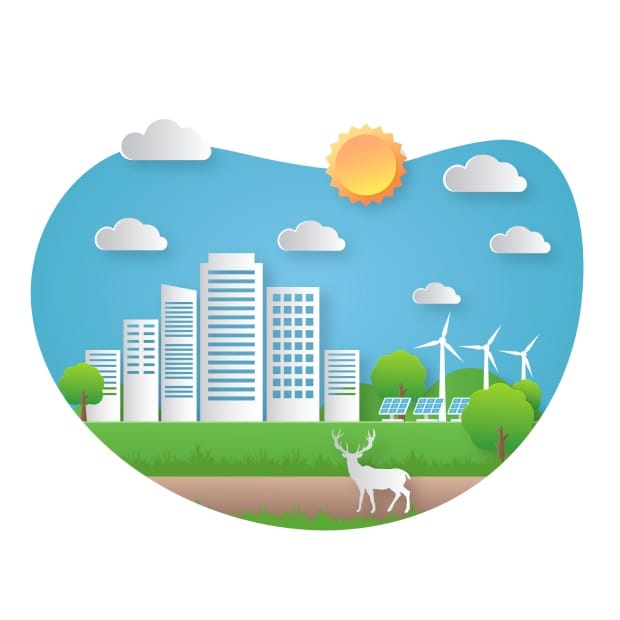Green technology, often referred to as sustainable technology, encompasses a range of innovative methods and systems designed to minimize environmental impact and promote sustainability. This approach prioritizes the utilization of resources in a manner that protects the planet while fostering economic growth. By integrating practices that are environmentally friendly, green technology aims to reduce ecological footprints and combat pressing issues such as climate change, resource depletion, and pollution.
The significance of green technology is apparent in today’s global landscape, where the degradation of natural ecosystems and the consequences of industrialization are increasingly pronounced. As populations grow, the demand for energy and resources intensifies, pressuring existing infrastructures and leading to unsustainable consumption patterns. The embrace of green technology offers viable solutions, facilitating a transition toward more efficient energy use, waste reduction, and conservation of natural resources.
Among the various innovations within this field, renewable energy sources such as solar, wind, and hydroelectric power are at the forefront, providing cleaner alternatives to fossil fuels. Additionally, advancements in energy-efficient appliances, sustainable materials, and waste management practices exemplify the breadth of applications that green technology encompasses. Collectively, these innovations not only reduce harmful emissions but also enhance resource efficiency, reducing reliance on non-renewable sources.
Furthermore, green technology plays a critical role in addressing climate change. The implementation of eco-friendly practices helps mitigate greenhouse gas emissions, thereby contributing to global efforts aimed at curbing climate-related disasters. Understanding and investing in these technologies is paramount in fostering a sustainable future, ensuring that natural ecosystems are preserved for generations to come. As we delve deeper into the various facets of green technology, its impacts and potential shall become increasingly evident.
Historical Context and Evolution
The development of green technology has a rich history that dates back several centuries. Early innovations in renewable energy, such as wind and solar power, can be traced back to ancient civilizations. Windmills, for instance, were utilized for various purposes as early as 500 AD in Persia, while solar energy was harnessed by the Greeks as they designed buildings to capture sunlight for heating. These early applications set the groundwork for further advances in sustainable energy practices.
The 20th century marked a significant turning point in the evolution of green technology, particularly following the 1973 oil crisis, which prompted governments and researchers worldwide to reconsider their energy sources. The crisis highlighted the vulnerabilities associated with fossil fuel dependency and spurred investments in alternative energy solutions. In the United States, the establishment of the Department of Energy in 1977 signaled a commitment to developing renewable energy technologies, further enhancing research into both solar and wind power.

As the environmental movement gained momentum in the late 20th century, pivotal policy frameworks emerged, such as the Clean Air Act and the Energy Policy Act, which fostered the development of green technology. These regulations not only encouraged investment in renewable energy sources but also helped propel advancements in energy efficiency and sustainable practices across various industries. The rise of electric vehicles in the 21st century is a prime example of this ongoing evolution; innovations in battery technology and government incentives have significantly improved the viability of electric transportation.
In more recent years, sustainable agriculture practices have emerged, demonstrating the wide-ranging impacts of green technology on food production and ecosystem management. This evolution illustrates a broader shift towards an integrated and holistic understanding of sustainability, paving the way for future innovations that prioritize environmental stewardship and ecological balance.
Current Trends in Green Technology
The landscape of green technology is rapidly evolving, with significant trends emerging as industries and consumers alike recognize the importance of sustainability. One of the most prominent trends is the increasing adoption of renewable energy sources. Solar, wind, and hydropower are becoming mainstream alternatives to fossil fuels, with advancements in technology improving efficiency and reducing costs. This shift not only helps to decrease carbon emissions but also supports nations worldwide’ energy independence.
In conjunction with renewable energy, energy storage solutions are gaining traction. As the generation of renewable energy can be intermittent, the ability to store excess energy for use during low production times is crucial. Innovations in battery technology, such as lithium-ion and solid-state batteries, are enhancing the storage capacity and longevity of energy systems. This trend is pivotal for both grid stability and consumer energy management, allowing for greater integration of renewable sources into national grids.
Another significant trend is the development of smart grids, which utilize advanced technology to monitor and manage energy distribution more effectively. Smart grids improve energy efficiency by allowing real-time communication between utilities and consumers, facilitating demand response initiatives. These systems are integral to optimizing energy use and integrating renewable power sources smoothly into the existing infrastructure.

Moreover, the incorporation of artificial intelligence (AI) in environmental monitoring is reshaping how industries assess their impact on the environment. AI-driven technologies analyze data from various sources to forecast energy consumption patterns, improve resource management, and enhance predictive maintenance of equipment. These capabilities empower businesses to make informed decisions that align with sustainable practices.
As these trends continue to develop, the green technology sector is positioning itself as a critical component in addressing global environmental challenges and promoting a sustainable future.
The Role of Government and Policy
The development of green technology is profoundly influenced by government policies and regulations. These frameworks often serve as catalysts for innovation in sustainable practices and technologies. By implementing various incentives, governments can stimulate investments in clean energy, thus facilitating the transition towards a greener economy. Subsidies, tax breaks, and funding for research and development are commonly employed mechanisms that encourage businesses to invest in renewable energy sources and environmentally friendly technologies.
Further, international environmental agreements play a crucial role in shaping national policies that prioritize sustainability. Treaties such as the Paris Agreement set binding targets for emissions reductions, prompting countries to develop robust green technology sectors. Through cooperative frameworks, nations can share innovations and best practices, thereby accelerating progress in sustainable technology initiatives. Such international collaboration is essential for addressing global challenges such as climate change, which know no borders.
At the local level, government initiatives can have a significant impact on promoting green technology adoption. Municipal programs focused on energy efficiency, waste reduction, and sustainable urban planning offer tangible benefits to communities and incentivize the adoption of eco-friendly practices. Local authorities often engage in public-private partnerships that encourage innovation and support for startups specializing in green technology, creating an ecosystem conducive to sustainable advancements.
Moreover, regulatory frameworks that establish standards for emissions and waste management drive industries to pursue greener alternatives. The establishment of clean energy targets forces companies to rethink their operations and invest in more sustainable practices. Therefore, the collaboration between government entities and the private sector is vital for the development and dissemination of innovative green technologies.
Given the significant influence of policy and regulation on green technology, continued government support is pivotal in fostering an environment where sustainable innovations can thrive.
Investments and Economic Impact
The economic landscape is undergoing a significant transformation with the rise of green technology. As concerns about climate change and environmental degradation escalate, investments in sustainable practices are becoming increasingly attractive to businesses and investors alike. The allocation of funds towards green technology not only addresses environmental challenges but also presents a compelling business model that can drive profitability and innovation.

In recent years, global investment in green technology has surged, driven by both government and private sector initiatives. Governments around the world are offering various funding sources including grants, tax incentives, and subsidies to stimulate the development of sustainable technologies. These financial incentives encourage corporations to adopt greener practices, thereby accelerating the transition towards a low-carbon economy. Notably, the renewable energy sector, comprising solar, wind, and bioenergy, has witnessed tremendous growth, reflecting a growing recognition of the importance of sustainable energy solutions.
Moreover, the shift towards green technology is creating substantial job opportunities. According to recent studies, the green sector has the potential to generate millions of jobs globally, ranging from engineering to manufacturing and research. The demand for skilled labor in areas such as renewable energy installation, energy efficiency, and environmental management is on the rise. This influx of employment opportunities contributes to economic stability and growth, while simultaneously addressing climate change through the adoption of sustainable practices.
As businesses recognize the need for sustainable practices, they are increasingly integrating green technology into their operational strategies. Companies that invest in eco-friendly innovations can improve their competitiveness and resilience in the face of environmental challenges. Therefore, the economic impacts of green technology extend beyond mere financial incentives; they contribute to a broader vision of sustainable development—driving strategic investments and fostering an eco-conscious workforce.
Challenges Facing Green Technology
The advancement of green technology is pivotal for fostering a sustainable future, yet several challenges hinder its widespread implementation and development. One significant barrier is technological limitation. While innovations in green technology, such as renewable energy sources and energy-efficient solutions, are rapidly evolving, many of these technologies are still in the early stages of development. For instance, battery storage systems, essential for effective renewable energy use, can often be expensive and not yet sufficiently efficient to meet current energy demands. As a result, the integration of these technologies into existing infrastructures remains a complex undertaking.
Economic constraints also play a crucial role in the challenges faced by green technology. The transition from conventional energy sources to sustainable alternatives often requires substantial upfront investments in research, development, and new infrastructure. Many governments and industries may struggle to allocate the necessary finances to support the transition, particularly in regions where traditional energy sources have historically dominated the market. Additionally, the economic benefits of green technologies may not be immediately apparent, causing hesitation among investors and stakeholders.
Public resistance can further complicate the progress of green technology. Many individuals and communities may be unfamiliar with the advantages of adopting green technologies, leading to skepticism about their effectiveness. Furthermore, there may be concerns about the potential impacts on jobs within traditional industries that could be affected by the shift toward more sustainable practices. This resistance often manifests in opposition to new projects, making it difficult for policymakers and innovators to implement necessary changes.
Overcoming these challenges is essential to accelerate the advancement of green technology. With thoughtful consideration of the technological, economic, and societal factors at play, innovators and policymakers can work collaboratively to develop solutions that promote a sustainable approach to energy and resource management.
Case Studies of Successful Green Technologies
The integration of green technology across various sectors has yielded notable success stories that highlight its potential for positive environmental impacts. In the energy sector, the implementation of solar photovoltaic systems has transformed how we utilize natural resources. Companies like SunPower and First Solar have pioneered advancements that not only improve efficiency but also reduce the carbon footprint associated with energy generation. By harnessing energy directly from the sun, these solar technologies exemplify an innovative approach towards sustainable electricity solutions.
Another sector where green technology has made significant strides is transportation. Electric vehicles (EVs) have emerged as a sustainable alternative to traditional fossil fuel-powered cars. Tesla’s development of high-performance electric cars, such as the Model S and Model 3, showcases how green technology can lead to improved air quality and decreased greenhouse gas emissions. Additionally, the establishment of charging infrastructure has further encouraged the adoption of EVs, demonstrating the symbiotic relationship between technological innovation and sustainable transportation practices.
Furthermore, the agricultural sector is witnessing transformative changes through the adoption of green technology. Precision farming techniques, such as those employed by companies like CropX, utilize data analytics and IoT devices to enhance crop yields while minimizing resource usage. By implementing these innovations, farmers can decrease water consumption and fertilizer application, subsequently reducing their environmental impacts and aligning with sustainable development goals.
These case studies exemplify the profound effects that green technology can have across various industries. Not only do these innovations showcase a commitment to reducing environmental footprints, but they also highlight the potential for economic growth and job creation within sectors that prioritize sustainability. As the world continues to face ecological challenges, these successful implementations serve as a testament to the viability and necessity of investing in green technologies for a sustainable future.
The Future of Green Technology
The future of green technology presents a landscape rife with potential advancements that can significantly mitigate environmental challenges while promoting sustainable practices. As society grapples with the effects of climate change, the importance of ongoing research and development (R&D) in green technology becomes increasingly clear. Emerging technologies, such as artificial intelligence (AI) and blockchain, are being harnessed to optimize energy consumption and resource management. For instance, AI can analyze vast data sets to improve energy efficiency in homes and industries, while blockchain technology secures transparent supply chains, reducing waste and carbon footprints.

The potential breakthroughs in renewable energy sources, particularly solar and wind, are also noteworthy. Innovations such as perovskite solar cells and floating wind farms are paving the way for more efficient energy generation, making green technology more accessible. Furthermore, developments in energy storage solutions, such as advanced battery technologies, play a vital role in stabilizing energy supplies and boosting the reliability of renewable resources. As these technologies mature, we may witness a fundamental shift in how society approaches energy production and consumption.
Moreover, green technology is poised to expand into novel sectors such as agriculture and transportation. Precision agriculture, utilizing sensors and drones, leads to more efficient resource use, reducing the environmental impact of farming. In transportation, electric and hydrogen-fueled vehicles are gaining traction, supported by innovations in infrastructure, such as widespread charging stations. These advancements highlight the interconnectivity of various sectors and the collective move towards a green economy.
Finally, collaboration among governments, industries, and academia is essential to drive research and innovation in green technology further. Public policies that incentivize renewable energy projects and promote sustainable practices will be crucial for fostering growth in this field. By prioritizing green technology, society can work towards a sustainable future where environmental integrity and economic growth coexist harmoniously.
Conclusion and Call to Action
The landscape of our planet is undergoing significant changes, brought about by the pressing need for sustainability. As evidenced throughout this discussion, green technology serves as a catalyst for reducing environmental impacts and fostering a healthier planet. Innovations in renewable energy, waste management, and sustainable agriculture are not merely trends but essential components in our collective effort to combat climate change and protect natural ecosystems. It is crucial for individuals, communities, and policymakers to acknowledge the vital role that green technology plays in our future.
One of the most effective ways to contribute to this movement is through active engagement with green initiatives within your own community. Supporting local projects that focus on renewable energy installations, community gardens, and waste reduction programs can have a significant impact, no matter the scale. Even small personal actions, such as reducing energy consumption, embracing public transportation, or advocating for eco-friendly practices in daily life, can collectively lead to substantial benefits. Each commitment to sustainability helps create a ripple effect that encourages others to make conscious choices that align with green technology principles.
Moreover, it is imperative to voice our support for policies that prioritize the advancement of green technology. Engaging with local representatives and advocating for legislation that promotes sustainability can drive systemic change. By highlighting the importance of a sustainable economy and investing in innovative solutions, we can shift the narrative towards a greener and more resilient future.
In conclusion, the integration of green technology into our daily lives and the support for sustainable practices is essential for mitigating environmental impacts. By actively participating in local initiatives and advocating for progressive policies, we can contribute to a healthier and more sustainable future for all. Your involvement matters; every effort counts in this critical journey towards a greener world.


